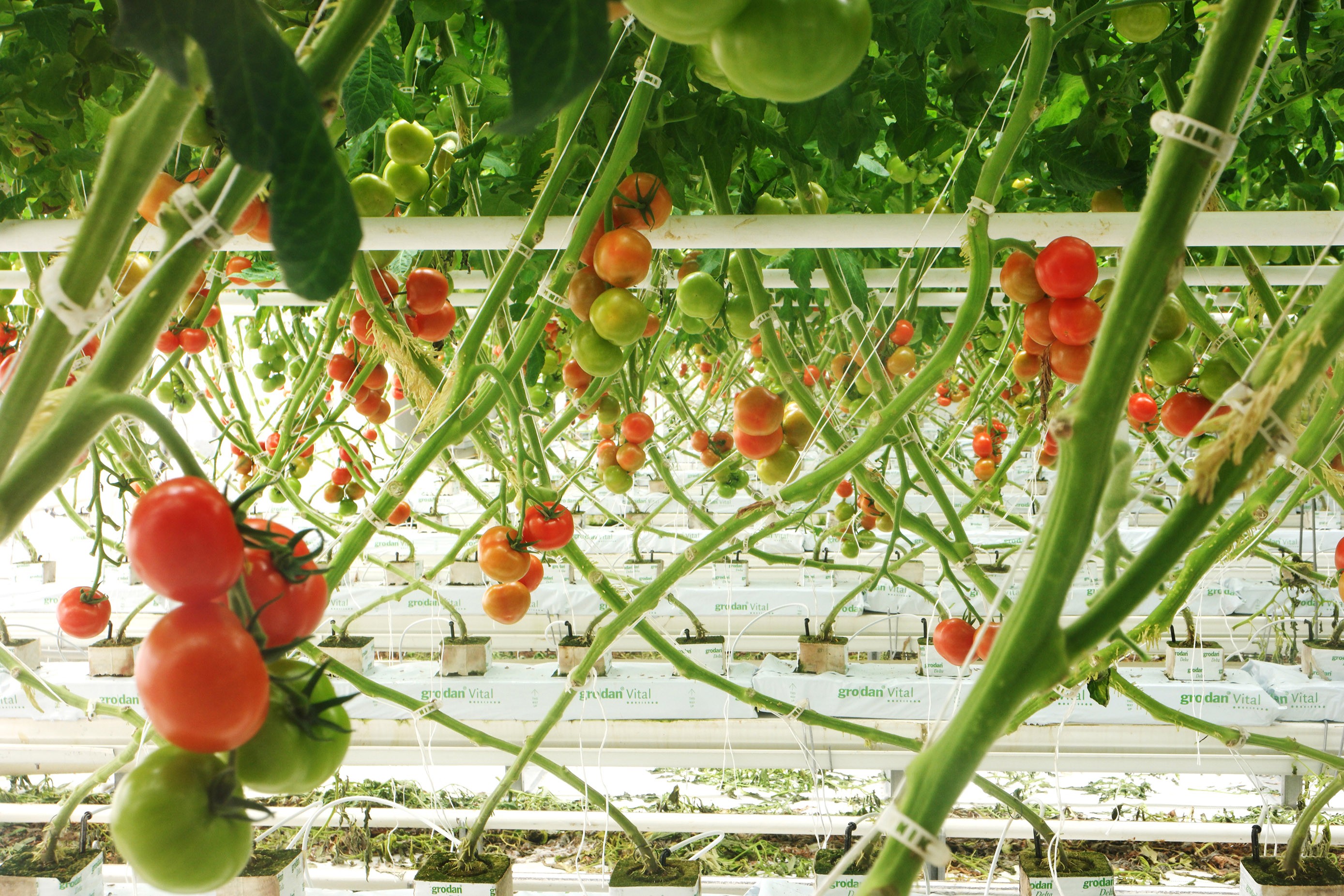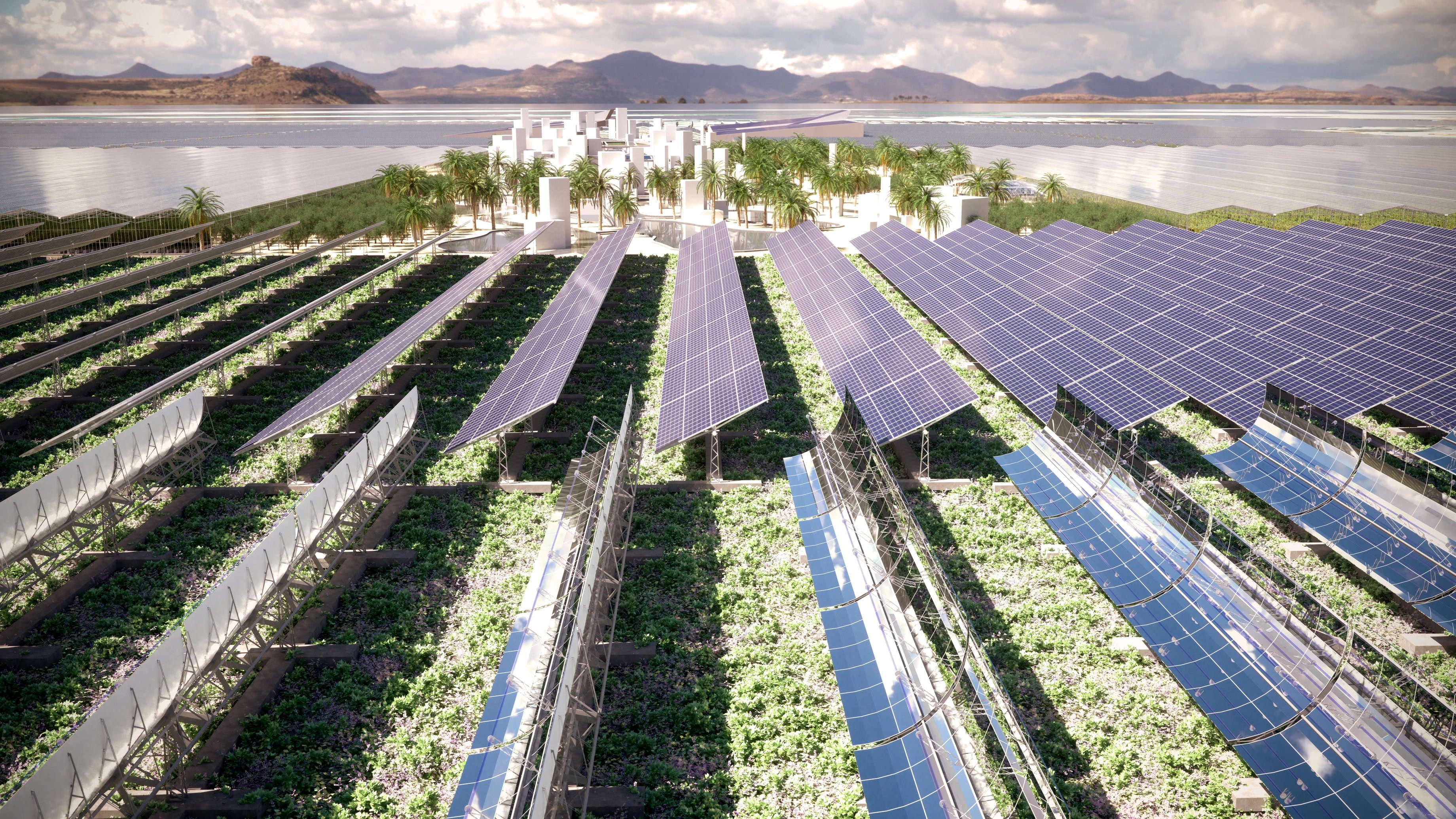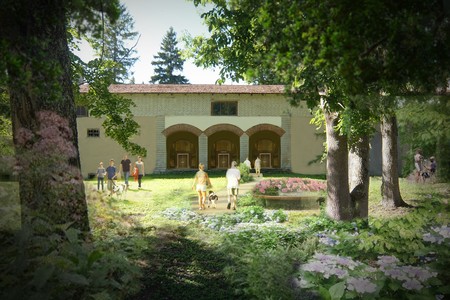-
“Taking into account a growing population and shifting diets, the world will need to produce 69% more food calories in 2050 than we did in 2006.”
Serenity Farms is the world's largest and fully self-sufficient greenhouse facility, providing profitable food production and sustaining communities in some of our harshest environments. Even more impressive, the complex sources seawater, is powered entirely by solar energy, and provides fresh fruit and vegetables to over 180,000 people. The first site for this ground-breaking concept will be on Saudi Arabia's west coast and incorporated under the Reza Investment Company.

Serenity Farms is shifting the goalposts and showing the world how it's possible to produce healthy, consistent, high-quality fresh produce for people living in arid and semi-arid regions. People living in these kinds of areas currently rely on two main types of produce:
- locally-sourced, water-intensive, and low-quality, or
- expensive, air-freighted, and far from fresh.
Our solutions reduce emissions, and costs, minimize aquifer depletion and water use, and actively enhance sustainability by bolstering food security. Besides countless other benefits, the most significant is that Serenity Farms establishes itself as a unique non-oil-based economic engine in a region perilously dominated by the fossil fuel industry.
Serenity Farms in a nutshell
Serenity Farms showcases a new food production industry for the future - one that provides fresh food to dry and arid regions, long-term quality jobs, enhanced education, and sustainable economic growth. It not only increases national food production and food security but reduces the environmental footprint and non-renewable resource use.
- At 110ha, Serenity Farms is home to the world's largest greenhouse complex.
- World's first large-scale commercial greenhouse using non-aquifer water sources.
- Uses 100% desalinated seawater directly from the Red Sea.
- Saves 9.2 billion liters of water/year, preserving over 95% when compared to an open field.
- It utilizes 100% solar energy and is entirely fossil-fuel-free, reducing its carbon footprint.
- Reliably produces healthy, quality, and fresh food for more than 180,000 people.
- Enhances food security and sustainability of the community.
- Establishes new industries and up to 50,000 sustainable jobs.
- Provides a US$1 billion boost to the local economy over 10 years.
- Creates an immersive knowledge development industry on sustainable food production (in cooperation with KAUST university.)
- Employs up to 3000 skilled and educated workers.
- Enhances training, education, capacity development, and local human capital.
- Reduces CO2 emissions by eliminating imported and air-freighted fresh food supplies.
- Prepares for future industrial symbiosis: connects organic waste sources from hospitality and poultry farms, sources CO2 from the atmosphere and adjacent industries and utilizes plant fibers for packaging.
- Overseen by a financially rewarding investment structure, including managed risk and phased scaling.


Growing food in the desert
There are many factors putting pressure on our world's driest environments. Most notably, the effects of climate change, dwindling agricultural resources, and the continued pace of population growth add to the collective inability to grow enough produce. Generally speaking, the arider the country, the more it will suffer in this regard.
Waning food security and its effects on national autonomy are a significant concern to countries. with low domestic food production, particularly Saudi Arabia and others in the Gulf Cooperation Council ( GCC.)

In Saudi Arabia, freshwater (aquifer) sources are on the verge of depletion. It doesn't rain nearly enough to refill them at the pace they are currently being used, putting local agriculture under severe strain.
Furthermore, growing populations are increasingly making other nations dependent on international trade. Long-term, this overreliance on a far-away place doesn't help and increases the risk to food security and requires expensive, carbon-intensive cooled air freight movements. This overreliance not only reduces the quality but hinders the development of a more local, higher quality, and sustainable agriculture in the desert a reality.
We initiated the Serenity Farms project to overcome this phenomenon.
Serenity Farms employs the latest in Dutch greenhouse and energy utilization technology, ensuring the project is capable of sustaining itself by:
- Providing 100% of the water used on site is desalinated seawater.
- Reducing water consumption by more than 95% compared to the local open-field agriculture.
- Utilizing solar energy from thermal and PV sources across the entire complex.

Water: the source of all life
Those living in semi-arid and desert regions are not wanting for more sunshine. It is water that is the scarcest and most valuable resource. Without it, life as we know it ceases to exist.
Due to the last century and unprecedented consumption, many regions have started to depend more on their underground water sources. Saudi Arabia, as one example, has depleted over 80% of its aquifer reserves in the last 50 years alone and is facing dire consequences.
The government has banned water use in open-field agriculture for cereal and livestock feed crops to prolong the remaining water reserves and mitigate economic damage.
Despite taking the necessary steps, the aquifers won't be able to replenish themselves for centuries, if ever, and many Saudis and investors expect more protectionist interventions under the KSA government's "Vision 2030."
Serenity Farms sets a precedent for this new and emergent industry - compliant with Saudi Arabia's future vision and one that will stand the test of time. There is a high potential to expand across the GCC region and many other arid regions worldwide.
The end of the fossil-fuel era
Global efforts mean that many nations are slowly but steadily turning their backs on fossil fuels. Countries that had built economies on old and polluting industries are now preparing for the future and the inevitable shift from oil.
Saudi Arabia is facing this challenge head-on, directly addressing its concerns with Vision 2030", which declares the dire need to develop a significant and sustainable non-oil economy. Income is already being directed from oil-based industries to alternative energy sources in a bid to bolster resilience and autonomy,
Serenity Farms stands to be among the first in this new and emergent industry to cease the reliance on fossil fuels by utilizing renewable energy sources and enhancing food security. By reducing demands on non-renewables for energy and freight, the Saudi government can save up to 57 tons of CO2 per year, equivalent to the average annual emissions of 17,000 petrol cars.

The future of sustainable arid food production
To ensure a viable long-term solution that fits into a local context. After a strenuous review of the challenges, we participated in a co-creation process to develop solutions to the many interlinked challenges and the best way to overcome them.
Our client's local knowledge was invaluable for this research process in geographic, economic, and technological scenarios. They helped us accurately analyze current systems and develop solutions to growing systems, saline production, algae cultivation, and aquaculture.
Serenity Farms is the answer - an enormous greenhouse complex utilizing renewable energy sources, non-aquifer water supplies, closed-loop waste systems, and relocalizing and simplifying the supply chain. The aim is to be a self-sufficient cultivation system that supports up to 180,000 residents.
This agriculture is good for the environment and community, is financially robust, flexible with crop choice, and can operate year-round. The structure and the systems underpin it allow for future expansion and provide facilities to produce organic fertilizers, waste recycling, CO2 atmospheric scrubbing, and green packaging production.

Simulating the desert environment
Except created an advanced simulation tool to help understand the complexity and challenges to the economic feasibly in producing large amounts of food in arid environments. With the help of elaborate algorithms, it's possible to integrate performance specifications of high-end technological solutions to address climate control, water treatment, energy production, and nutrient mixing technologies.
This advanced learning and assessment process ensures the Serenity Farms concept is adaptable to unique differences in environment, context, and technological advancement. The tool enables alternate scenario testing and the in-depth analysis of the inherent tradeoffs between technology, resource-use, land-use, profitability, logistics, and countless operational decisions.

Jan. 15, 2020
Client & Partners
Project team
-
Tom Bosschaert
Director
-
Jacob Verhaart
Head of Science, Industrial Ecologist
-
Monica Visniuc Industrial Ecologist
-
-
Emma Westerduin
Architect and Project Manager
-
Antonia Sore Architect
-
Jeroen van der Vlist
Chief Operations Officer (COO)
-
Tim Horsten
CSR Consultant / Engineer
-
Tim Ewart Project Manager
-
Gertjan van Hardeveld Business Strategist






